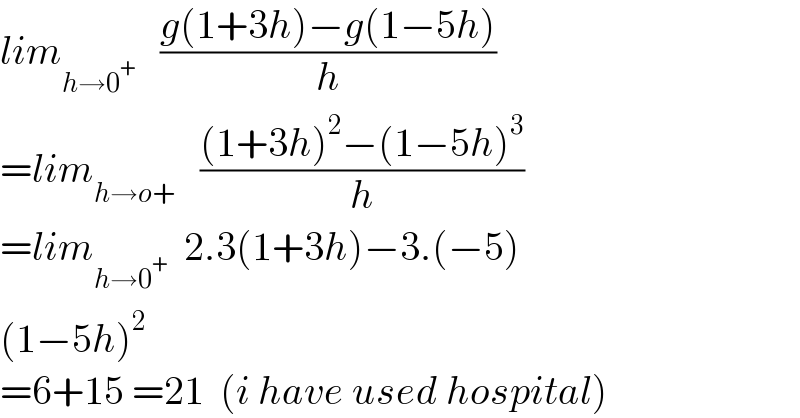
Question Number 167105 by mnjuly1970 last updated on 06/Mar/22

$$ \\ $$ $$\:\:\:\:\mathrm{I}{f}\:\:\:\:{g}\left({x}\right)=\:\begin{cases}{\:{x}^{\:\mathrm{2}} \:\:\:\:\:{x}\geqslant\mathrm{1}}\\{\:{x}^{\:\mathrm{3}} \:\:\:\:\:\:\:{x}<\:\mathrm{1}}\end{cases}\: \\ $$ $$\:\:\:\:\:\:{then}\:\:\:\:\:{lim}_{\:{h}\rightarrow\:\mathrm{0}^{\:+} } \frac{\:{g}\:\left(\mathrm{1}+\mathrm{3}{h}\:\right)\:−\:{g}\:\left(\mathrm{1}−\mathrm{5}{h}\:\right)}{{h}}\:=? \\ $$
Answered by greogoury55 last updated on 06/Mar/22

$$\:\underset{{x}\rightarrow\mathrm{0}^{+} } {\mathrm{lim}}\frac{{g}\left(\mathrm{1}+\mathrm{3}{h}\right)−{g}\left(\mathrm{1}−\mathrm{5}{h}\right)}{{h}} \\ $$ $$\:=\:\underset{{x}\rightarrow\mathrm{0}^{+} } {\mathrm{lim}}\:\mathrm{3}{g}\:'\left(\mathrm{1}+\mathrm{3}{h}\right)+\mathrm{5}\:{g}\:'\left(\mathrm{1}−\mathrm{5}{h}\right) \\ $$ $$\:=\:\mathrm{8}\:{g}'\left(\mathrm{1}\right)=\:\mathrm{8}×\mathrm{3}×\left(\mathrm{1}\right)^{\mathrm{2}} =\:\mathrm{24} \\ $$ $$ \\ $$
Commented bymnjuly1970 last updated on 06/Mar/22

$$\:{please}\:{recheck} \\ $$
Answered by Mathspace last updated on 07/Mar/22

$${lim}_{{h}\rightarrow\mathrm{0}^{+} } \:\:\:\frac{{g}\left(\mathrm{1}+\mathrm{3}{h}\right)−{g}\left(\mathrm{1}−\mathrm{5}{h}\right)}{{h}} \\ $$ $$={lim}_{{h}\rightarrow{o}+} \:\:\:\frac{\left(\mathrm{1}+\mathrm{3}{h}\right)^{\mathrm{2}} −\left(\mathrm{1}−\mathrm{5}{h}\right)^{\mathrm{3}} }{{h}} \\ $$ $$={lim}_{{h}\rightarrow\mathrm{0}^{+} } \:\:\mathrm{2}.\mathrm{3}\left(\mathrm{1}+\mathrm{3}{h}\right)−\mathrm{3}.\left(−\mathrm{5}\right) \\ $$ $$\left(\mathrm{1}−\mathrm{5}{h}\right)^{\mathrm{2}} \\ $$ $$=\mathrm{6}+\mathrm{15}\:=\mathrm{21}\:\:\left({i}\:{have}\:{used}\:{hospital}\right) \\ $$
Answered by alephzero last updated on 08/Mar/22

$${g}\left({x}\right)\:=\:\begin{cases}{{x}^{\mathrm{2}} }&{{x}\:\geqslant\:\mathrm{1}}\\{{x}^{\mathrm{3}} }&{{x}\:<\:\mathrm{1}}\end{cases} \\ $$ $$\Rightarrow\:\underset{{x}\rightarrow+\mathrm{0}} {\mathrm{lim}}\frac{{g}\left(\mathrm{1}+\mathrm{3}{x}\right)−{g}\left(\mathrm{1}−\mathrm{5}{x}\right)}{{x}}\:= \\ $$ $$=\:\underset{{x}\rightarrow+\mathrm{0}} {\mathrm{lim}}\frac{\left(\mathrm{3}{x}+\mathrm{1}\right)^{\mathrm{3}} −\left(\mathrm{5}{x}−\mathrm{1}\right)^{\mathrm{3}} }{{x}} \\ $$ $$\frac{{d}}{{dx}}\left(\mathrm{3}{x}+\mathrm{1}\right)^{\mathrm{3}} \:=\:\frac{{d}}{{d}\left(\mathrm{3}{x}+\mathrm{1}\right)}\left(\mathrm{3}{x}+\mathrm{1}\right)^{\mathrm{3}} ×\frac{{d}}{{dx}}\left(\mathrm{3}{x}+\mathrm{1}\right)\:= \\ $$ $$=\:\mathrm{9}\left(\mathrm{3}{x}+\mathrm{1}\right)^{\mathrm{2}} \\ $$ $$\frac{{d}}{{dx}}\left(\mathrm{5}{x}−\mathrm{1}\right)^{\mathrm{3}} \:=\:\frac{{d}}{{d}\left(\mathrm{5}{x}−\mathrm{1}\right)}\left(\mathrm{5}{x}−\mathrm{1}\right)^{\mathrm{3}} ×\frac{{d}}{{dx}}\left(\mathrm{5}{x}−\mathrm{1}\right)\:= \\ $$ $$=\:\mathrm{15}\left(\mathrm{5}{x}−\mathrm{1}\right)^{\mathrm{2}} \\ $$ $$\Rightarrow\:\underset{{x}\rightarrow+\mathrm{0}} {\mathrm{lim}}\:\left(\mathrm{9}\left(\mathrm{3}{x}+\mathrm{1}\right)^{\mathrm{2}} −\mathrm{15}\left(\mathrm{5}{x}−\mathrm{1}\right)^{\mathrm{3}} \right) \\ $$ $$=\:\mathrm{9}\left(\mathrm{1}\right)^{\mathrm{2}} −\mathrm{15}\left(−\mathrm{1}\right)^{\mathrm{3}} \:=\:\mathrm{9}−\left(−\mathrm{15}\right)\:= \\ $$ $$=\:\mathrm{24} \\ $$
Commented bycortano1 last updated on 08/Mar/22

$$\:\:\frac{\mathrm{d}}{\mathrm{dx}}\left(\mathrm{3x}+\mathrm{1}\right)^{\mathrm{3}} \:=\:\mathrm{9}\left(\mathrm{3x}+\mathrm{1}\right)^{\mathrm{2}} \\ $$
Commented byalephzero last updated on 08/Mar/22

$$\mathrm{sorry}\:\mathrm{for}\:\mathrm{mistake}!\:\mathrm{i}'\mathrm{ve}\:\mathrm{corrected} \\ $$ $$\mathrm{now}. \\ $$
Commented bymr W last updated on 08/Mar/22

$${it}\:{is}\:\left(\mathrm{3}{x}+\mathrm{1}\right)^{\mathrm{2}} ,\:{not}\:\left(\mathrm{3}{x}+\mathrm{1}\right)^{\mathrm{3}} ! \\ $$ $${you}\:{had}\:{many}\:{typos}. \\ $$
Answered by mr W last updated on 07/Mar/22

$${g}\left(\mathrm{1}+\mathrm{3}{h}\right)=\left(\mathrm{1}+\mathrm{3}{h}\right)^{\mathrm{2}} =\mathrm{1}+\mathrm{2}×\left(\mathrm{3}{h}\right)+{o}\left({h}\right) \\ $$ $${g}\left(\mathrm{1}−\mathrm{5}{h}\right)=\left(\mathrm{1}−\mathrm{5}{h}\right)^{\mathrm{3}} =\mathrm{1}+\mathrm{3}×\left(−\mathrm{5}{h}\right)+{o}\left({h}\right) \\ $$ $${lim}_{\:{h}\rightarrow\:\mathrm{0}^{\:+} } \frac{\:{g}\:\left(\mathrm{1}+\mathrm{3}{h}\:\right)\:−\:{g}\:\left(\mathrm{1}−\mathrm{5}{h}\:\right)}{{h}} \\ $$ $$={lim}_{\:{h}\rightarrow\:\mathrm{0}^{\:+} } \frac{\:\mathrm{1}+\mathrm{6}{h}+{o}\left({h}\right)\:−\mathrm{1}+\mathrm{15}{h}+{o}\left({h}\right)}{{h}} \\ $$ $$={lim}_{\:{h}\rightarrow\:\mathrm{0}^{\:+} } \frac{\:\mathrm{21}{h}+{o}\left({h}\right)}{{h}} \\ $$ $$=\mathrm{21} \\ $$
